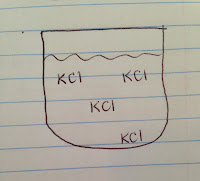1.
a. The changes I would see in the beaker if I dissolved 40g KCl at 50'C and then let it cool to room temperature at 25'C would be a supersaturated solution. Because at first the solution was unsaturated, and when it cooled, it became supersaturated because the solution contained more KCl than it can contain at a lower temperature.
b.
2.
a. Solution made by dissolving 20g KCl in 100g water at 40'C:
i. Model of a solution that is kept at 40'C with one- fourth of the water evaporated. This solution differs from the original solution because it is more concentrated since water was taken out and not equally distributed.
ii. 20g of water must evaporate at this temperature to create a saturated solution.
3.
a. Solution containing 10g KCl in 100g water at 25'C.
b. Dilute the solution by adding 100g of water.
c. The key features that are different in questions 3a and 3b is that in 3b the amount of water added was doubled making the solution's concentration less than that in 3a. Therefore, making the potassium chloride (KCl) in 3b more spread out.







No comments:
Post a Comment